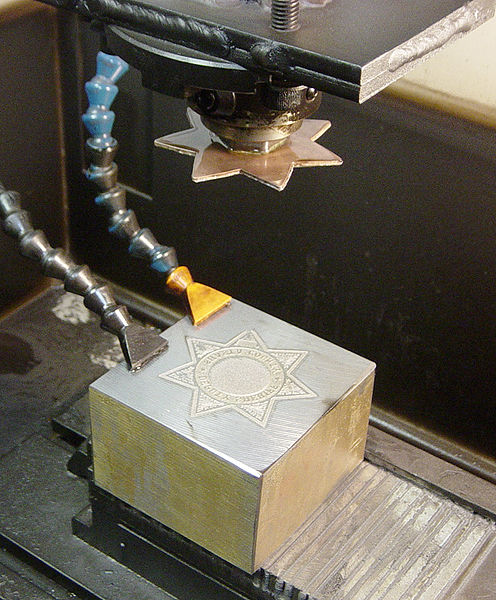Electrical discharge machining
Electrical discharge machining (EDM), also known as spark machining, spark eroding, die sinking, wire burning or wire erosion, is a metal
fabrication process whereby a desired shape is obtained by using electrical discharges (sparks). Material is removed from the work piece by a series of rapidly recurring current discharges between two electrodes, separated by a dielectric liquid and subject to an electric voltage. One of the electrodes is called the tool-electrode, or simply the tool or electrode, while the other is called the workpiece-electrode, or work piece. The process depends upon the tool and work piece not making physical contact. Extremely hard materials like carbides, ceramics, titanium alloys and heat treated tool steels that are very difficult to machine using conventional machining can be precisely machined by EDM.
An electrical discharge machine
CNC Wire-cut EDM machine
Master at top, badge die workpiece at bottom, oil jets at left (oil has been drained). Initial flat stamping will be "dapped", see sinking (metalworking), to give a curved surface.
EDM control panel (Hansvedt machine). Machine may be adjusted for a refined surface (electropolish) at end of process.
In machining, numerical control, also called computer numerical control (CNC), is the automated control of tools by means of a computer. It is used to operate tools such as drills, lathes, mills, grinders, routers and 3D printers. CNC transforms a piece of material into a specified shape by following coded programmed instructions and without a manual operator directly controlling the machining operation.
A CNC machine that operates on wood
CNC machines typically use some kind of coolant, typically a water-miscible oil, to keep the tool and parts from getting hot.
Sinker EDM. Electrolyte solution saturates the workpiece, and voltage is applied between the sinker, top, and workpiece, bottom.
Waterjet cutting machine







